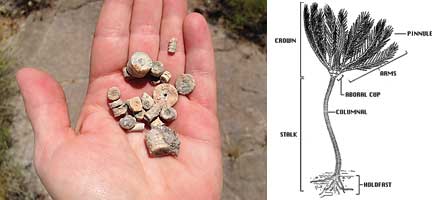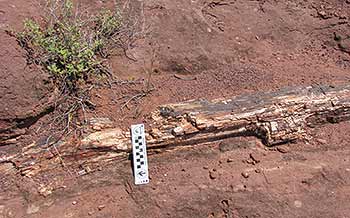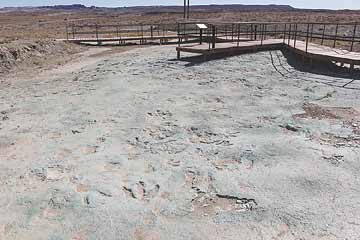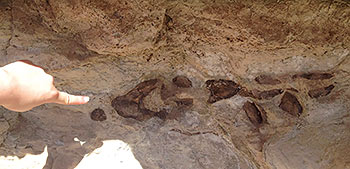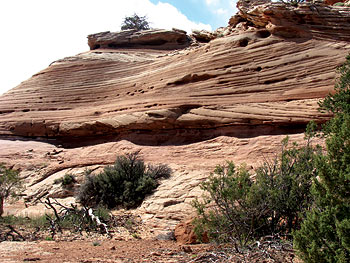Geology HAPPENINGS October 2019 |
||||||||||
| Spelling Out the Definition of FOSSIL by Allyson Mathis |
||||||||||
The term “fossil” is one of those words whose usage in common language is somewhat different than its strict scientific definition. In everyday conversation, we call anything that is old, out-of-date, or old-fashioned a fossil. Sometimes people worry that, as they get older, they will become fossils themselves. Youngsters may think that their parents or grandparents already are fossils.
My favorite definition of fossil spells it out: FOSSIL Fantastically Old Stone-like Specimen Indicating Life. While this definition was developed by National Park Service paleontologist Vince Santucci in a somewhat jocular effort to see if he could create an acronym from the word, it still captures the key elements of the more formal definition: evidence of life in a geologic context. Considering common types of fossils like shells of varying types, corals, petrified wood, leaf impressions, worm burrows, bones, shark teeth, and animal tracks is a good way to explore the definition in further detail. Overall, there are two main types of fossils: body fossils and trace fossils (also known as ichnofossils). Body fossils are the “remains of life”: bones, shells, wood, teeth, leaves, etc. and are usually made up of only the hard parts of animals and plants. Hence petrified wood is much more common than fossil flowers, although under the right conditions, delicate plant and animal tissues may be preserved.
Dinosaur tracks and animal burrows are trace fossils, falling into the “evidence of life” subcategory. Trace fossils can provide evidence of how an animal lived and of behaviors that can’t be directly inferred from body fossils, and can reveal how an animal interacted with the environment within which it lived. For example, dinosaur trackways can provide information about how fast the animals moved and whether they traveled together in groups. Fossils only are preserved under certain geologic conditions. Taphonomy is the branch of paleontology that examines how organisms decay and become fossilized. Rapid burial by sand, mud and/or other sediments is one of the most critical factors that increases the odds of preservation. Animal and plant remains left exposed on the earth’s surface are likely to decompose, get scavenged, or be scattered. Riverbanks and floodplains, swamps, lakes and marine basins provide good environments for fossilization because sedimentation rates are commonly high, and some aqueous environments impede decomposition due to low oxygen conditions.
A variety of chemical and physical changes usually occur during fossilization. Petrification takes place when organic material is converted into stone. Permineralization is the gradual addition of chemically-precipitated substances into pore spaces or cavities in bone, wood or shell. Replacement is a chemical substitution of the original hard parts with mineral matter, commonly silica or calcite. Sometimes molds (impressions) of organisms or casts (replicas of organisms formed by infilling molds) are found as fossils. Carbonization is the process that leaves only the carbon of a plant or animal as fossil material. Rock layers (formations) contain other features that provide information about ancient environments, but these features (known as sedimentary structures) are not fossils as they do not provide evidence of life. For example, ripple marks and cross bedding tell of ancient wind or water currents, and gravel deposits may provide evidence of ancient river channels. Geologists study sedimentary structures along with fossils to get a more complete picture of the environments in which plants and animals lived and rock layers were deposited.
Fossils are found in many of the rock layers near Moab. Marine invertebrate fossils such as crinoids, corals and brachiopods are found in the Honaker Trail Formation, and petrified wood is present in the Chinle and Morrison formations. The most exciting, and the most scientifically significant, fossils in southeastern Utah are of dinosaurs. Both dinosaur body fossils (bones) and extensive trackways are found near Moab. The Morrison and Cedar Mountain formations contain important bone beds, and tracks have been found in many layers, including the Curtis and Cedar Mountain formations. Fossils can be viewed easily along several interpretive trails in the Moab area. Bone fossils can be found on the Mill Canyon Dinosaur Trail. The best place to see dinosaur tracks is the Mill Canyon Dinosaur Tracksite where more than 200 individual tracks have been discovered from several types of dinosaurs. Tracks are also present at several other sites such as near the Poison Spider Trailhead off of the Potash Road. All fossils on federal public lands are protected by the Paleontological Resources Protection Act. Like archeological resources, fossils provide important insights into past life. It is up to all of us to preserve these Fantastically Old Stone-like Specimens Indicating Life for their scientific and educational value, and their benefit to future generations.
|
||||||||||
|
||||||||||
